Nikola Tesla - Free Energy Receiver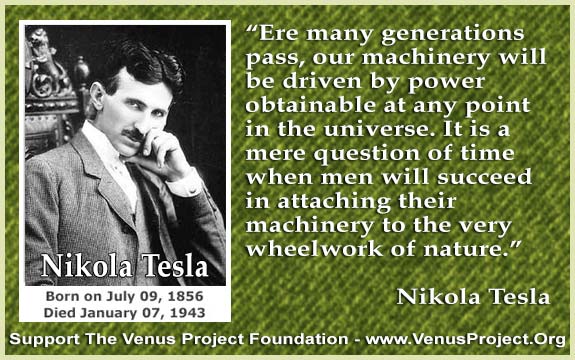
Top 10 Greatest Inventions by Nikola Tesla
The Lost Inventions of Nikola Tesla
- By George Trinkaus
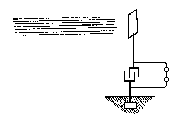 For starters, think of this as a solar-electric panel. Tesla's invention is very different, but the closest thing to it in conventional technology is in photo-voltaics. One radical difference is that conventional solar-electric panels consist of a substrate coated with crystalline silicon; the latest use amorphous silicon. Conventional solar panels are expensive, and, whatever the coating, they are manufactured by esoteric processes.
For starters, think of this as a solar-electric panel. Tesla's invention is very different, but the closest thing to it in conventional technology is in photo-voltaics. One radical difference is that conventional solar-electric panels consist of a substrate coated with crystalline silicon; the latest use amorphous silicon. Conventional solar panels are expensive, and, whatever the coating, they are manufactured by esoteric processes.
But Tesla's "solar panel" is just a shiny metal plate with a transparent coating of some insulating material which today could be a spray plastic. Stick one of these antenna-like panels up in the air, the higher the better, and wire it to one side of a capacitor, the other going to a good earth ground. Now the energy from the sun is charging that capacitor.
Connect across the capacitor some sort of switching device so that it can be discharged at rhythmic intervals, and you have an electric output. Tesla´s patent is telling us that it is that simple to get electric energy. The bigger the area of the insulated plate, the more energy you get. But this is more than a 'solar panel' because it does not necessarily need sunshine to operate. It also produces power at night.
Of course, this is impossible according to official science. For this reason, you could not get a patent on such an invention today. Many an inventor has learned this the hard way. Tesla had his problems with the patent examiners, but today's free-energy inventor has it much tougher. At the time of this writing, the U. S. Patent Office is headed by a Reagan appointee who came to the office straight from a top executive position with Phillips Petroleum.
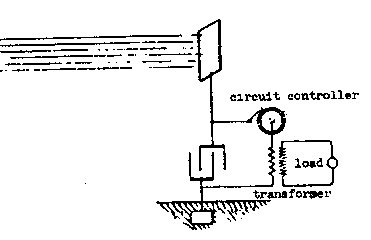 Tesla's free-energy receiver was patented in 1901 as An Apparatus for the Utilization of Radiant Energy. The patent refers to "the Sun, as well as other sources of radiant energy, like cosmic rays." That the device works at night is explained in terms of the night-time availability of cosmic rays. Tesla also refers to the ground as "a vast reservoir of negative electricity."
Tesla's free-energy receiver was patented in 1901 as An Apparatus for the Utilization of Radiant Energy. The patent refers to "the Sun, as well as other sources of radiant energy, like cosmic rays." That the device works at night is explained in terms of the night-time availability of cosmic rays. Tesla also refers to the ground as "a vast reservoir of negative electricity."
Tesla was fascinated by radiant energy and its free-energy possibilities. He called the Crooke's radiometer (a device which has vanes that spin in a vacuum when exposed to radiant energy) "a beautiful invention." He believed that it would become possible to harness energy directly by "connecting to the very wheelwork of nature." His free-energy receiver is as close as he ever came to such a device in his patented work.
But, on his 76th birthday, at the ritual press conference, Tesla (who was without the financial wherewithal to patent but went on inventing in his head) announced a "cosmic-ray motor." When asked if it was more powerful than the Crooke's radiometer, he answered, "thousands of times more powerful."
How it works
From the electric Potential that exists between the elevated plate (plus) and the ground (minus), energy builds in the capacitor, and, after "a suitable time interval," the accumulated energy will "manifest itself in a powerful discharge" which can do work. The capacitor, says Tesla, should be "of considerable electrostatic capacity," and its dielectric made of "the best quality mica,' for it has to withstand potentials that could rupture a weaker dielectric.
Tesla gives various options for the switching device. One is a rotary switch that resembles a Tesla circuit controller. Another is an electrostatic device consisting of two very light, membranous conductors suspended in a vacuum. These sense the energy build-up in the capacitor, one going positive, the other negative, and, at a certain charge level, are attracted, touch, and thus fire the capacitor. Tesla also mentions another switching device consisting of a minute air gap or weak dielectric film which breaks down suddenly when a certain potential is reached.
The above is about all the technical detail you get in the patent. Although I've seen a few cursory references to Tesla's invention in my sampling of the literature of free-energy, I am not aware of any attempts to verify it experimentally.
Plauson's converter - How it works
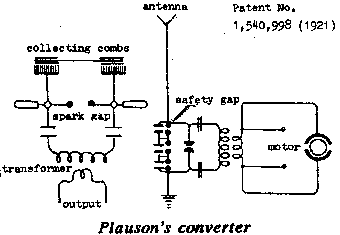
Nikola Tesla

Pretty much everybody even remotely associated with real-time strategy games has heard the name Tesla before – the Serbian God of Lightning's omnipresent, ever-zapping coils have been ruining the lives of digital Allied soldiers and gibbing U.S. war machines into spare parts since the release of Command & Conquer: Red Alert in 1996 – but surprisingly few people these days are familiar with the life and times of one of humankind's most eccentric, badass, and volumetrically-insane scientific super-geniuses.
First off, Nikola Tesla was brilliant. And not just like Ken Jennings brilliant, either - I mean like, "holy crap my head just exploded (from all the awesome)" brilliant. The Croatian-born engineer spoke eight languages, almost single-handedly developed technology that harnessed the power of electricity for household use, and invented things like electrical generators, FM radio, remote control, robots, spark plugs, fluorescent lights, and giant-ass machines that shoot enormous, brain-frying lightning bolts all over the place like crazy. He had an unyielding, steel-trap photographic memory and an insane ability to visualize even the most complex pieces of machinery – the guy did advanced calculus and physics equations in his damn head, memorized entire books at a time, and successfully pulled off scientific experiments that modern-day technology STILL can't replicate. For instance, in 2007 a group of lesser geniuses at MIT got all pumped up out of their minds because they wirelessly transmitted energy a distance seven feet through the air. Nikola Tesla once lit 200 light bulbs from a power source 26 miles away, and he did it in 1899 with a machine he built from spare parts in the middle of the god-forsaken desert. To this day, nobody can really figure out how the hell he pulled that shit off, because two-thirds of the schematics only existed in the darkest recesses of Tesla's all-powerful brain.
Of course, much like many other eccentric giga-geniuses and diabolical masterminds, Tesla was also completely insane. He was prone to nervous breakdowns, claimed to receive weird visions in the middle of the night, spoke to pigeons, and occasionally thought he was receiving electromagnetic signals from extraterrestrials on Mars. He was also obsessive-compulsive and hated round objects, human hair, jewelry, and anything that wasn't divisible by three. He was also asexual and celibate for his entire life. Basically, Nikola Tesla was the ultimate mad scientist, which is seriously awesome.
Another sweet thing about Tesla is that he conducted the sort of crazy experiments that generally result in hordes of angry villagers breaking down the door to your lab with torches and pitchforks. One time, while he was working on magnetic resonance, he discovered the resonant frequency of the Earth and caused an earthquake so powerful that it almost obliterated the 5th Avenue New York building that housed his Frankenstein Castle of a laboratory. Stuff was flying off the walls, the drywall was breaking apart, the cops were coming after him, and Tesla had to smash his device with a sledge hammer to keep it from demolishing an entire city block. Later, he boasted that he could have built a device powerful enough to split the Earth in two. Nobody dared him to prove it.
Tesla also ordered the construction of the Wardenclyffe Tesla Tower, a giant building shaped like an erect penis that would have housed the largest Tesla coil ever built. The massive structure, ostensibly designed to wirelessly transmit power, has been cited as a potential cause of the mysterious 1908 Tunguska Event – a ten-megaton blast that detonated in the wastelands above central Russia that completely obliterated and deforested everything unlucky enough to be located within a several hundred mile radius. While nothing has ever successfully proven Tesla's involvement in the ass-destroyingly huge explosion, it's pretty awesome that this guy could potentially have detonated a weapon 1,000 times more powerful than the nuclear bomb that destroyed Hiroshima, and have done it back before they'd even invented the submachine gun.
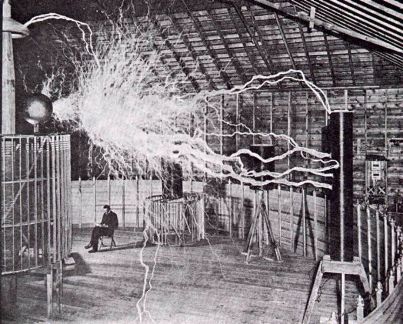
Tesla in his lab.
During his adventures blinding half of the world with science, Nikola Tesla harnessed the power of Niagara Falls into the first hydroelectric power plant, constructed a bath designed to cleanse the human body of germs using nothing but electricity, and created a 130-foot long bolt of lightning from one of his massive coils (a feat which to this day remains the world record for man-made lightning), but perhaps his most badass invention was his face-melting, tank-destroying, super-secret Atomic Death Ray. In the 1920s he claimed to be working on a tower that could potentially have spewed forth a gigantic beam of ionized particles capable of disintegrating aircraft from 200 miles away and blinking most men out of existence like something out of a Flash Gordon or Buck Rogers comic. His weapon, known as the "Teleforce Beam", allegedly shot ball lightning at 60 million volts, liquefying its targets with enough power to vaporize steel, and, while it could shoot further than 200 miles, its effectiveness beyond that range was limited only by the curvature of the Earth. Luckily for all humans, this crazy insanity never came to fruition – most of the schematics and plans existed only in Tesla's head, and when he died of heart failure in 1943, little hard data on the project existed. Still, J. Edgar Hoover and the FBI confiscated all his personal stuff and locked it away anyways, just to be safe.
Despite being incredibly popular during his day, now Tesla remains largely overlooked among lists of the greatest inventors and scientists of the modern era. Thomas Edison gets all the glory for discovering the lightbulb, but it was his one-time assistant and life-long arch-nemesis, Nikola Tesla, who made the breakthroughs in alternating-current technology that allowed for people to cheaply use electricity to power appliances and lighting in their homes. They constantly fought about whether to use alternating or direct-currents (their bitter blood feud resulted in both men being snubbed by the Nobel Prize committee), but ultimately Tesla was the one who delivered the fatal kick-to-the-crotch that ended the battle – at the 1893 World's Fair in Chicago, his AC generators illuminated the entire experience, marking the first time that an event of that magnitude had ever taken place under the glow of artificial light. Today, all homes and appliances run on Tesla's AC current.
Nikola Tesla was one of those super-genius badasses whose intellect placed him dangerously on the precipice between "great scientific mind" and "utter madness". He held 700 patents at the time of his death, made groundbreaking discoveries in the fields of physics, robotics, steam turbine engineering, and magnetism, and once melted one of his assistants' hands by overloading it with X-rays - which isn't really scientific, but is still pretty cool. And honestly, if there were one man on this planet who was ever capable of single-handedly destroying the entire planet through his insane scientific discoveries, it was Tesla. That alone should qualify him as a pretty righteous badass.
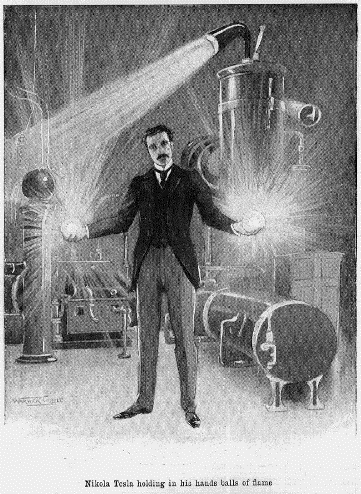
The caption reads: "Nikola Tesla holding in his hands balls of flame."
Download the audio file of the Nikola Tesla, science talk on WBAI Radio
Internet is the voice of the voiceless. Internet is an open forum for discussion, exchange of ideas, collaboration and community building. Internet is the community of true democracy and freedom loving people to share democratic values and principles all over the world.
Internet is a direct threat to the United States of Nation-less Corporations and the European Union of Nation-less Corporations current parliamentary dictatorships, masquerading as democracy.
The Nation-less corporations who own all government's officials are hard at work to turn the Internet into a censored and tightly controlled network for imposing their criminal and greedy means through their constant barrage of dumbing down agenda and mindless consumerism all over the world. We must stop these criminal bastards now!
New Ways of Censoring the Internet
- By DAVID JOLLY - The New York Times - February 5, 2012
PARIS -- European activists who participated in American Internet protests last month learned that there was political power to be harnessed on the Web. Now they are putting that knowledge to use in an effort to defeat new global rules for intellectual property.
In the U.S. protests , Web sites including Wikipedia went dark Jan. 18, and more than seven million people signed Google’s online petition opposing the Stop Online Piracy Act and the Protect Intellectual Property Act. Ultimately, even the bills’ sponsors in the U.S. Congress backed down under the onslaught of public criticism.
The European activists are hoping to use similar pressure to stop the international Anti-Counterfeiting Trade Agreement, or ACTA, which is meant to clamp down on illegal commerce in copyrighted and trademarked goods. Opponents say that it will erode Internet freedom and stifle innovation. About 1.5 million people have signed a Web petition calling for the European Parliament to reject ACTA, which some say is merely SOPA and PIPA on an international level. Thousands of people have turned out for demonstrations across Europe, with more scheduled for next Saturday.
After more than three years of talks, which critics say were conducted without sufficient public input , the United States signed on to ACTA last October in Tokyo, along with Australia, Canada, Japan, Morocco, New Zealand and South Korea. (The agreement is to come into force when six of those countries have ratified it.)
But the issue moved into the mainstream in Europe after the European Union and representatives of 22 of 27 E.U. members — all except Cyprus, Estonia, Germany, the Netherlands and Slovakia — signed Jan. 26.
On the same day, Kader Arif, a French Socialist member of the European Parliament, quit as the body’s special rapporteur for ACTA. He said the European Parliament and civil society organizations had been excluded from the negotiations, and he denounced the entire process as a “masquerade.” The issue, which had gotten little traction in the news media previously, began to move into the headlines, with calls for national legislatures and the European Parliament to reject the treaty.
The pressure on politicians has been unrelenting. Helena Drnovsek-Zorko, the Slovenian diplomat who signed the treaty on behalf of her country, has publicly disowned it and called for her fellow citizens to demonstrate against it. Ms. Drnovsek-Zorko said that she had signed “out of civic carelessness” and that it was her conviction that ACTA “limits and withholds the freedom of engagement on the largest and most significant network in human history.”
Poland, the home of some of the most vocal protests to date, “suspended” ratification, said the Polish prime minister, Donald Tusk, after politicians wearing the Guy Fawkes masks favored by the online vigilante group Anonymous protested in the Polish Parliament.
ACTA seeks to provide a common framework of civil and criminal procedures to stop illegal trade in goods and properties — like Louis Vuitton bags, Hollywood films and recorded music — providing holders of intellectual property rights with the means to work through the courts outside their national borders to shut down counterfeiters and pirates. And though two piracy heavyweights, Russia and China, have not signed, ACTA’s drafters say they hope those countries will come to see the benefits of joining.
Mr. Arif, the opponent to the measure in the European Parliament, said that ACTA was “wrong in both form and substance.”
He said European officials, who began negotiating the agreement in 2007, kept legislators in the dark for years and ignored their concerns, finally presenting them with a finished deal for ratification with no option of modifying it.
“Voilà, that’s the masquerade that I denounce,” he said. Mr. Arif said a number of issues in the agreement troubled him, particularly a provision that could make Internet service providers liable for copyright infringement by users, something that would be in conflict with existing E.U. law.
Another provision, he said, appeared to roll back protections for generic drugs by lumping them in with counterfeit drugs.
Further, he said, the law leaves to the discretion of each country the definition of what constitutes a “commercial” level of piracy, so some countries might choose to search travelers’ laptop computers and digital music players in search of illegal downloads. ACTA supporters reject the criticism and say action is essential when legitimate owners of intellectual property are losing tens of billions of dollars annually to counterfeiting and illegal sharing. They accuse some opponents of deliberately exaggerating ACTA’s provisions to fan fears.
“ACTA is about enforcing existing intellectual property rights and about acting against large-scale infringements often pursued by criminal organizations, and not about pursuing individual citizens,” said John Clancy, the E.U. trade spokesman.
The goal of the treaty, he said, was to raise standards around the world to European standards, not to crack down in Europe. “It’s simply misleading to suggest that ACTA would limit the freedom of the Internet,” Mr. Clancy added. “ACTA is not about checking private laptops or smartphones at borders. It will not cut access to the Internet or censor any Web sites.”
Ron Kirk, the U.S. trade representative, said in October that protecting intellectual property was “essential to American jobs in innovative and creative industries” and that the treaty “provides a platform for the Obama administration to work cooperatively with other governments to advance the fight against counterfeiting and piracy.”
The United States and the European Union dismiss the charge that the talks were not transparent, with U.S. trade officials arguing that the negotiating partners released the ACTA draft agreement in April 2010 and that the final version has been public for more than a year.
In the United States, too, ACTA has attracted criticism, but probably because its provisions are aimed at piracy overseas, there has been less controversy than for SOPA and PIPA. The NetCoalition, the alliance of technology companies including Google and eBay that fought SOPA and PIPA, has been critical of ACTA, as well.
And about 75 law professors signed an open letter to President Barack Obama, in which they criticized what they said was the “intense but needless secrecy” under which the negotiations were carried out, as well as the White House’s argument that Mr. Obama had the authority to endorse ACTA not as a treaty, which would require the advice and consent of the Senate, but rather as “a sole executive agreement.”
That has not gone over well in the U.S. Congress. “There are questions of constitutional authority surrounding whether the administration can enter into this agreement without Congress’s approval,” said Senator Ron Wyden, Democrat of Oregon.
“Either way, when international accords, like ACTA, are conceived and constructed under a cloak of secrecy,” Mr. Wyden said, “it is hard to argue that they represent the broad interests of the general public. The controversy over ACTA should surprise no one.”
The malicious software infected four million computers worldwide
7 Charged in Web Scam Using Ads
- By SOMINI SENGUPTA and JENNA WORTHAM - The New York Times - November 9, 2011
It was a subtle swap: a cheesy advertisement for a vacation timeshare site atop the home page of ESPN.com, in a spot that might have been claimed by a well-known brand like Dr Pepper.
Those who saw swapped ads, federal prosecutors say, might never have known that their computer had been drawn into a complex Internet advertising scam that they say generated $14 million for its creators.
Over the last four years, a group of men in Eastern Europe quietly hijacked millions of computers worldwide and diverted unsuspecting users to online advertisements from which they could profit, federal law enforcement officials said on Wednesday.
Six men, all in their 20s and early 30s, are under arrest in Estonia for what the United States attorney’s office in New York called “a massive and sophisticated Internet fraud scheme.” A Russian suspect in the case remains at large.
The malicious software infected four million computers worldwide, including 500,000 in the United States, the prosecutors said. The software was so subtle that most people using an infected computer were probably unaware of it.
It was a two-pronged scheme, prosecutors said. One component involved redirecting clicks on search results to sites that were controlled by the defendants. A search for “I.R.S.,” for instance, would lead a user to the Web site of the tax preparer H&R Block. The sites to which users were directed would pay the swindlers a referral fee, prosecutors said. The more traffic they could redirect, the more fees they collected.
The other way the group made money, according to the indictment, was to swap legitimate online advertisements on certain Web sites with others that would generate payments for the defendants. Prosecutors said that Web sites for ESPN and The Wall Street Journal were affected — but only when viewed on the infected computers.
“On a mass scale, this gave new meaning to the term false advertising,” Preet Bharara, the United States attorney for the Southern District of New York, said at a press conference in Manhattan.
The security firm Trend Micro, which was among several private companies that helped federal officials with the investigation, called it the “biggest cybercriminal takedown in history.” The group running the scheme had 100 command-and-control servers worldwide, the company said, one of which was in a data center run in New York.
The scheme came to light after 100 computers at the National Aeronautics and Space Administration were found to have been infected. The malicious software spread through infected Web sites.
The most serious aspect of the scheme was that it attacked part of the scaffolding of the Internet: the domain name system, or D.N.S., which links the numerical addresses of Web sites with more user-friendly addresses like irs.gov.
“When people start attacking infrastructure, it creates the potential for a rogue version of the Internet,” said David Dagon, a computer security expert at the Georgia Tech College of Computing who helped federal authorities in the investigation.
Unlike more traditional malware that ferrets out valuable personal information, the group’s program was not designed to steal data, so it was not easily detected, private security consultants said. It manipulated the infrastructure of the Web to do what it does every day in great volumes: display advertising.
All six of the Estonian defendants were in the custody of Estonian police. Four of them also face charges in that country. One of them, Vladimir Tsastsin, 31, has been previously convicted of money laundering in Estonia, according to the Federal Bureau of Investigation. He is identified with a company called Rove Digital, which investigators say ran the operation’s infrastructure.
According to the indictment, the malware also staved off antivirus software updates, which meant that an infected computer could not detect that it was infected. This also made the machine vulnerable to other security bugs.
The malware affected both Windows and Mac operating systems. On its web site, the F.B.I. outlines how to detect this particular program and how to get rid of it.
Mr. Bharara described the scheme as “cyber infestation of the first order” that reflected the global nature of Internet fraud.


